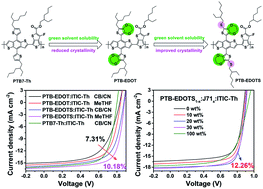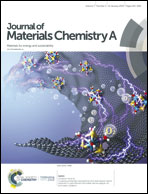Green solvent-processed efficient non-fullerene organic solar cells enabled by low-bandgap copolymer donors with EDOT side chains†
Abstract
In this study, by engineering ethylenedioxythiophene (EDOT) side chains we developed two novel low-bandgap copolymers, namely, PTB-EDOT and PTB-EDOTS, for fabricating green solvent-processed but highly efficient non-fullerene organic solar cells (NF-PSCs). This molecular design strategy not only featured copolymers with excellent solubility in the green solvent 2-methyltetrahydrofuran (MeTHF) but also introduced a low-lying HOMO level, a high extinction coefficient and high crystallinity. PTB-EDOTS-based binary blend NF-PSCs exhibited a PCE of 9.28% when ITIC-Th was used as the acceptor and chlorobenzene/1-chloronaphthalene (CB/CN) as the processing solvent. When MeTHF was used instead of CB/CN, the PCE was further increased to 10.18%. To compensate for the weak absorption in the short-wavelength region and further optimize the morphology, a polymer donor (J71) with a large bandgap was added as a third component to fabricate ternary blend NF-PSCs. After the addition of 20 wt% of J71, NF-PSCs exhibited improved absorption and fine-tuned morphology. Charge transport and energy transfer were also promoted by this ternary blend strategy via an electron cascade effect, a “hole back” phenomenon and a Förster resonance energy transfer (FRET) process, which increased the maximum PCE to 12.26% with a very high fill factor (FF) of 75.6%. To the best of our knowledge, this is the best performance achieved by NF-PSCs using green solvents.

- This article is part of the themed collection: 2019 Journal of Materials Chemistry A HOT Papers


 Please wait while we load your content...
Please wait while we load your content...